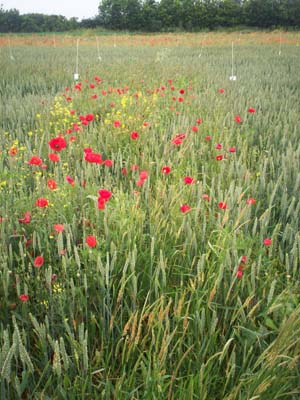
Based on the active ingredient flumioxazin, SumiMax is a new contact and residual acting herbicide for winter wheat, offering excellent control of a wide range of broad-leaved weeds as well as useful control of annual meadow-grass, rye-grass and black-grass. It is being seen as a foundation herbicide for both black-grass and non-black-grass programmes.
Dr. David Stormonth, Technical Manager for Interfarm explains that SumiMax has been launched at a time when the range of chemical groups currently in use is limited and where resistance problems are growing. "The principal chemical groups being used for grass weed control are the dinitroanilines (pendimethalin and trifluralin), the substituted ureas (IPU and chlorotoluron), the sulphonylureas and the 'fop/dim/dens'. Flufenacet, an oxyacetamide herbicide, is also available in combinations. Grass weed resistance, particularly black-grass, to most of these groups has become a widespread and difficult problem. The impending loss of trifluralin and isoproturon had significantly reduced the choice available to UK growers," he points out.
"Whilst some of these autumn herbicides have broad-leaved weed activity, the spectrum is generally incomplete. The addition of actives such as diflufenican significantly improves the broad-leaved weed spectrum of many autumn-applied herbicide products, but problem weeds can remain, requiring farmers to overspray in the spring. The introduction of a new herbicide from a different chemical group with a wide broad-leaved weed spectrum and also grass weed activity will be of interest to many UK wheat growers," says David.
"SumiMax introduces a brand new molecule for the UK market, flumioxazin, which is from the N-phenyl-phthalimide group. Examples of other compounds in this group are flumezin, flumiclorac and flumipropyn. Such compounds have found use in mainly warmer climate crops such as maize, peanuts, soybean, rice, vines and orchards," says Dr. Stormonth.
Flumioxazin is readily absorbed by foliage. It is also relatively long-lived in the soil, being absorbed by germinating seedlings of susceptible weeds, resulting in shoot necrosis and inhibition of root growth. It induces accumulation of porphyrins and enhances peroxidation of membrane lipids leading to irreversible damage of membrane function and structure in susceptible plants. It is a PPO inhibitor with both soil surface residual and contact activity.
Dr. Stormonth explains that the mode of action of flumioxazin is different from all other products currently in use for weed control in winter wheat in the autumn. "This could make a major contribution in the management of weed species which have developed resistance to many of the chemical groups in current use."
In terms of timing, SumiMax is recommended pre-emergence to early post-emergence in winter wheat up to before GS15, once the crop has hardened off. It has a low dose rate of just 100 ml/ha and has been proven to be safe across a range of wheat varieties.
Developed under the code INT804, Sumimax has been subject to an extensive development programme in the UK, with over 79 trials being done across many different geographic areas of the UK.
"This development work indicates that flumioxazin gives high levels of control of many broad-leaved weeds, including those that are regarded as more difficult to control, as well as offering very useful effects on some grass weeds. In trials when applied early post-emergence at 100ml/ha, flumioxazin gave 100% control of charlock, chickweed, fumitory, groundsel, field pansy, red deadnettle, ivy-leaved speedwell and mayweed, 99% control of cleavers, common field speedwell and Shepherds purse and 98% control of poppy," reports David.
"In trials SumiMax also gave up to 90% control of annual meadow-grass, 80% control of rye-grass and 65% control of black-grass," says Dr. David Stormonth.
"SumiMax also has the advantage of being able to be mixed with a useful range of grass weed herbicides as well as being able to be sequenced with any other herbicide or group. Having no following crop restrictions or following cultivation issues, all add up to a flexible herbicide to use in programmes," says David.
Barrie Hunt, Business Manager for Interfarm UK Ltd, sees SumiMax as an excellent foundation product for both black-grass and non black-grass situations. "SumiMax offers outstanding pre- or early post-emergence broad-leaved weed activity plus valuable grass weed activity in winter wheat, delivering season-long control."
In black-grass situations Barrie sees the product fitting in pre or very early post emergence when the black-grass has 1-2 leaves. "Here it can be mixed with other partner herbicides such as Liberator (flufenacet and DFF), Defy (prosulfocarb), chlorotoluron/IPU or alone. It can then be followed up by Atlantis (mesosulfuron-methyl and iodosulfuron-methyl-sodium) later in the autumn. Alternatively it can be used with Lexus (flupyrsulfuron-methyl) early post-emergence."
"In non-black-grass situations it will be the advanced solution for the non-IPU era, offering season-long control of Annual Meadow-grass and a wide range of broad-leaved weeds. Trials show that it performs very well on Annual Meadow-grass, much more consistently than IPU has done," says Barrie.
Barrie points out that SumiMax has some important added bonuses. "It is an easy to use, non-staining liquid formulation. It has very low active ingredient loading per hectare with the approved label dose rate of 100 ml/ha delivering just 30 gms a.i/hectare. Packed in a 500 ml clear, polyethylene bottle which will treat 5 hectares of wheat, it has minimal packaging, minimal transport cost and minimal packaging waste."
Barrie Hunt adds that three brands are being introduced in the UK, SumiMax, Digital® and Guillotine®. The products will be widely available throughout the UK and Ireland via Interfarm distributors.
